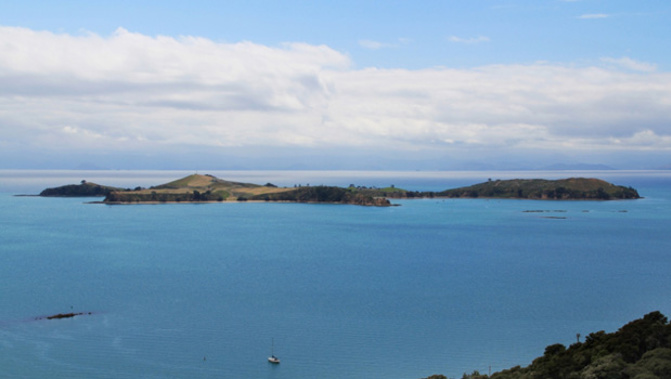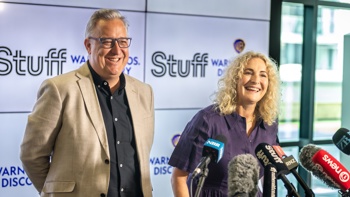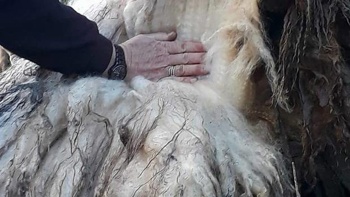
Regulatory headaches, slow action and conflict are dogging efforts to save Auckland's big blue backyard – now under unprecedented pressure from pollution and over-fishing.
The Hauraki Gulf Forum's damning stock take, released today, has revealed the state of the gulf is now deteriorating faster than any management efforts could tackle the degradation.
The forum's leaders have made pressing calls for action to new Conservation Minister Eugenie Sage, who in turn has blamed the previous Government for its "neglect" – calling the latest of the three-yearly report an "indictment of past inaction".
Its tone of urgency – and frustration - set the review apart from previous ones, as did some concerning new statistics about what was happening to the ecosystems the gulf supported.
Trevally numbers had now plummeted by 86 per cent from their historic levels, snapper by 83 per cent, and sharks - a key part of the ecosystem - by 86 per cent.
But more alarming was a warning from the statutory body's leaders that a much-vaunted collaborative marine spatial plan to help restore and manage the gulf would likely fall over.
A surge in population around the region – an extra 87,500 people had moved to the Auckland area since the last report, with half a million households now living around the gulf's fringes – was singled out as the single biggest change from 2014.
But it also set out 10 other broad areas of concern, ranging from water quality problems, pollution, declining fish stocks and pressure from fishing and aquaculture, to regulatory headaches and slow progress on implementing the Sea Change marine spatial plan.
That much-vaunted collaborative effort was created to recommend what activities should take place and where in the 1.2mha gulf marine park, determining what areas should be safe-guarded and shaping plans to come.
But Sea Change would "probably fail", wrote the forum's chair John Tregidga, and deputy Liane Ngamane, because it had no legal status and was therefore unenforceable, and was "probably unfundable, at least under present arrangements", given the cost involved in implementing it.
Progress on improving the gulf had also been dogged by legislative conflicts: notably between the Fisheries Act and Resource Management Act, which had made decision-making "challenging".
The forum leaders were especially scathing of Crown representatives appointed by the ministers of Conservation, Fisheries and Maori affairs, who, rather than working together to solve problems, had appeared as "passive reporters of ministry actions" or "advocates for single issue policies".
Problems had been exacerbated by courts ruling that the Hauraki Gulf Marine Park Act (HGMPA) had conflicting objectives, and the Crown was therefore obliged to take only very limited account of the legislation.
"Such a finding may significantly weaken the intended effect of the Act," the forum leaders wrote.
"In fact, the Fisheries Act resource utilisation objectives are directly in conflict with the objectives of the HGMPA in the Gulf."
It also appeared, they wrote, that "Crown risk management approaches for oil pipeline security, and potential oil leaks from a sunken ship may place the environment of the Hauraki Gulf in jeopardy".
Tregidga, Hauraki's mayor, called on Sage to "support and act upon a renewed, integrated programme of action across government agencies and partners".
"The key issue for the gulf is the current pace of change outstripping the ability of current management frameworks to respond effectively," the forum said in a press statement released today.
/arc-anglerfish-syd-prod-nzme.s3.amazonaws.com/public/TQKWIYOSONAPDEOKKOMK3A53NM.jpg)
Closed beaches have been a common occurrence this summer. Photo / File
"An ongoing constraint is the lack of an accepted, holistic and integrated plan across agencies, mana whenua and users."
Forest & Bird's Hauraki Gulf advocate Alicia Bullock also appealed to the Government to step up.
"Everything is place to bring back the health and wonder of the Gulf – we have the science, the stakeholder consensus, and a ground-breaking plan of action called Sea Change, but the keystone piece that's missing is political support," Bullock said.
"The Government has supported iwi, fishers, and environmental groups to develop an innovative, integrated solution for restoring the gulf.
"But now we need the Government to take Sea Change and turn it into action."
The gulf boasted one of the largest, most significant bio-regions of New Zealand, but its health as a functioning marine environment had been neglected by regional and national government for generations, she said.
"Sea Change will be transformative for the whole Hauraki Gulf region, but without political commitment things will continue to get worse.
"There will be more toxic beaches, fewer fish, and continued ecosystem destruction."
Sage told the Herald that previous National ministers had allowed the Sea Change plan to "sit on the shelf and gather dust".
"Restoring the Gulf to health will take a serious effort from everyone involved, especially given the challenges of population growth, and continuing nutrient and sediment pollution from land development," she said.
"I am actively considering the Forum's Sea Change report and working with Ministerial colleagues."
Evidence in the new report would help inform Government decisions, Sage said.
Paradise under pressure
The report found cumulative pressures on the sea were mounting, as human and commercial pressures ramped up.
Auckland's population had boomed over the last decade, increasing by almost a quarter of a million people between 2006 and 2016.
/arc-anglerfish-syd-prod-nzme.s3.amazonaws.com/public/UWPXXCDYAZCQHEY2O3OQD52TGA.jpg)
The decline of snapper in the Hauraki Gulf has been a major issue. Photo / File
Around 34 per cent of New Zealanders now lived in Auckland, and its population was projected to pass the two-million mark within 15 years.
The Auckland Unitary Plan provided for that growth through a combination of intensification and urban sprawl, with 15,000ha of rural land being earmarked for future development, but all of it would come at a continued cost.
Sewage already regularly overflowed from Auckland's wastewater reticulation system into the gulf's waterways, and stormwater outflows also remained a problem, especially in older urban areas.
Auckland Council has blacklisted 16 spots as unsafe for swimming, citing concerns over long-term water quality issues, and 11 others have temporary high risk warnings in place.
On top of that urban sprawl was increasing ocean sprawl, notably allocating more space for marine farms - 3290ha had been zoned or consented already – and for marinas, boat ramps, jetties, and potential new port facilities.
Invasive pests posed a threat to the marine environment – as did boating, fishing, and visits to reserves, which put pressure on fish stocks, disrupted wildlife and damaged benthic habitats.
Forest & Bird pointed out how one recently discovered large scallop bed had been destroyed after just four years of poorly managed fishing.
There were some small positives amid the gloom.
Heavy metal concentrations in Auckland's urban estuaries and nutrient loads from the Hauraki Plains remained high – an estimated 3666 tonnes of nitrogen and 198 tonnes of phosphorus flowed each year through four main rivers and into the gulf between 2006 and 2015 – but showed signs of improvement
Great Mercury Island had been declared pest-free, while speed restrictions to combat ship-strike had also brightened the outlook for one of the gulf's most prized resident species, the Bryde's whale.
"Almost all areas are naturally degraded and damaged by human activity," the report found, "yet they retain resilience - and are demonstrably restorable."
Five worrying figures
45%
Estimates suggest the gulf today supports less than 45 per cent of the fish "biomass" that it did in 1925, after decades of over-harvesting.
Snapper and rock lobster populations were well below target stock levels, while numbers of john dory, gurnard and trevally were also concerning.
Fishing had cut snapper rates by 80 per cent, with the biggest impact on old, large fish, and growth rates had slowed.
/arc-anglerfish-syd-prod-nzme.s3.amazonaws.com/public/ZXB7XIVVRZCDLO5JHXWJQVUR2I.jpg)
"Almost all areas are naturally degraded and damaged by human activity," the report found, "yet they retain resilience - and are demonstrably restorable." Photo / File
Similarly, crayfish numbers have been slashed to about 20 per cent of their 1945 levels.
While this was considered by managers to be well above the biomass necessary to sustain the maximum sustainable yield, those yields had fallen to their lowest rate since 1979/1980, and were regionally the lowest in New Zealand.
Government leaders and fisheries managers had set about rebuilding fish stocks, but, the report added, these plans had a "framework and ethos of stock utilisation objectives" that ran counter to laws and efforts to protect the gulf.
The forum leaders called for a "fundamental review" of fisheries legislation.
0.3%
Just 0.3 per cent of the gulf was protected by statutes other than the HGMPA.
There were six marine reserves constituted under the 1971 Marine Reserves Act, yet only one had been created in this century, and since the HGMPA had been in place.
"For most of this period the 1971 Act has been under review, promising a more appropriate legal framework, but that has not yet been delivered," the report noted.
It was in spite of a recent survey of Aucklanders indicating that more people had visited a
marine reserve in the gulf than had fished in its waters.
"Certainly there is strong public support for a more active programme of marine protected areas to be planned and implemented."
The forum leaders urged Sage to progress new marine protected areas legislation.
882,000m3
Between 2014 and 2016, staff from the Watercare Clean-up Trust spent around 6000 hours on clean-up activities, and together with a host of volunteers, removed around 882,000m3 marine litter from the coast.
Marine litter ending up on the gulf's beaches was dominated by plastics, which were environmentally persistent, spread widely and caused a wide range of harmful impacts.
Over 260 species including invertebrates, fish, seabirds and mammals have been reported to ingest or become entangled in plastic debris, resulting in impaired movement, feeding and breeding, cuts – and death.
The bulk of marine litter near Auckland mainly came from land-based sources, while fishing related material dominated further afield.
The amount of staff time put into marine litter collection had been steady since 2006, but even so, total annual volumes of marine litter removed had never fallen below 130,000 litres – and has even been as high as 507,000 litres.
40
Just 40 individuals of the New Zealand fairy tern – our most endangered species – and nine breeding pairs are estimated to remain.
The "nationally vulnerable" New Zealand storm petrel was thought to be extinct for 108 years, until it was rediscovered in 2003.
/arc-anglerfish-syd-prod-nzme.s3.amazonaws.com/public/AOL3HA5CSRAC7IBJC3ILLBWO6M.jpg)
NZ fairy tern numbers have dropped to 40 individuals. Photo / File
The petrel breeds on Little Barrier Island and the population is thought to be in the 100s to 1000s.
The nationally vulnerable black petrel is the seabird most at risk from commercial fishing activity, with an estimated 392 birds captured in 2013-2014. Of them over 100 were captured by the north-eastern snapper longline fishery.
Numbers of the flesh-footed shearwater population – the most common species incidentally captured by the north-eastern snapper longline fishery - has also been rapidly declining from 50,000-100,000 pairs estimated in 1984 to be less than 12,000 pairs currently.
Overall, however, seabird populations are rebounding in the wake of considerable investment in eradications of mammalian predators from islands and coasts.
5-20%
Beach monitoring data was pooled and compared for the following three summer periods: 2007-2010, 2010-2013 and 2013-2016.
In the Auckland region, around half of the monitored sites in each period exceeded the "action guideline" for microbial contamination on at least one occasion, while in the Waikato Region, 13 to 29 per cent of sites exceeded the action guideline at least once.
Beaches in the North Shore (Wairau Outlet, Castor Bay, Milford Beach, Takapuna Beach, Rothesay Bay) in Central Waitemata (Te Atatu Beach, St Mary's Bay), Howick (Mellons Bay), and Tairua Harbour had the most frequent exceedances, with an average percentage exceedance of 5-20 per cent for the period between 2007 and 2016.
Of the 34 beach sites monitored in both the 2007-2010 period and the 2013-2016 period, nine sites had worse water quality in 2013-2016, eleven sites were unchanged, and 14 sites had better water quality in 2013-2016.
The greatest improvements in microbial water quality occurred in Mellons Bay, Herne Bay and Cockle Bay, while the largest declines had occurred in Kohimaramara Beach and Tairua Harbour.
Beach monitoring indicates that action guideline values for contact recreation were occasionally exceeded on many Auckland and Coromandel beaches.
There had been large changes to the monitored beaches over the past decade, with monitoring ceasing at both the worst and the best beaches.
Take your Radio, Podcasts and Music with you









